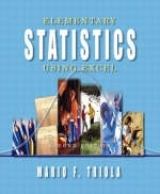
Elementary Statistics Using Excel
Pearson
978-0-201-69942-5 (ISBN)
- Titel erscheint in neuer Auflage
- Artikel merken
The use of algebra is minimal, although completion of an elementary algebra course is recommended.
For Introductory Statistics-Algebra-Based, Intro to Business Statistics-One or Two Term, Elementary Statistics Using Excel is written for the introductory statistics course where Excel is required. It is appropriate for students majoring in any field. The use of algebra is minimal, although completion of an elementary algebra course isrecommended. *Excel is integrated throughout the entire text with Excel-generated graphs and output, as well as instructions for obtaining the output. *Easily identifiable icons mark examples that use Excel and exercises where it would be appropriate to use Excel to solve the problem. *Internet Projects included at the end of every chapter involve the student in applications using data found on the Internet. The projects can be found at http://www.awl.com/Triola. *Interpretation of results is emphasized throughout the text, particularly in the worked examples and exercises. *More than half of the exercises use real data. In addition to the real data included throughout the book, many exercises refer to the 20 data sets listed in Appendix B.
*A CD-ROM, provided with the text, contains the Appendix B Data Sets formatted for Excel, and DDXL, an Excel add-in that extends Excels graphics and statistics capabilities. *Full-color design increases reader interest through a functional and visually appealing presentation.
1. Introduction to Statistics.
Overview.
The Nature of Data.
Uses and Abuses of Statistics.
Design of Experiments.
Introduction to Excel.
2. Describing, Exploring, and Comparing Data.
Overview.
Summarizing Data with Frequency Tables.
Pictures of Data.
Measures of Center.
Measures of Variation.
Measures of Position.
Exploratory Data Analysis.
3. Probability.
Overview.
Fundamentals.
Addition Rule.
Multiplication Rule: Basics.
Multiplication Rule: Complements and Conditional Probability.
Probabilities Through Simulations.
Counting.
4. Probability Distributions.
Overview.
Random Variables.
Binomial Probability Distributions.
Mean, Variance, and Standard Deviation for the Binomial Distribution.
The Poisson Distribution.
5. Normal Probability Distributions.
Overview.
The Standard Normal Distribution.
Nonstandard Normal Distributions: Finding Probabilities.
Nonstandard Normal Distributions: Finding Values.
The Central Limit Theorem.
Normal Distribution as Approximation to Binomial Distribution.
Determining Normality.
6. Estimates and Sample Sizes.
Overview.
Estimating a Population Mean: Large Samples.
Estimating a Population Mean: Small Samples.
Determining Sample Size.
Estimating a Population Proportion.
Estimating a Population Variance.
7. Hypothesis Testing.
Overview.
Fundamentals of Hypothesis Testing.
Testing a Claim about a Mean: Large Samples.
Testing a Claim about a Mean: Small Samples.
Testing a Claim about a Proportion.
Testing a Claim about a Standard Deviation or Variance.
8. Inferences from Two Samples.
Overview.
Inferences about Two Means: Independent and Large Samples.
Inferences about Two Means: Matched Pairs.
Inferences about Two Proportions.
Comparing Variation in Two Samples.
Inferences about Two Means: Independent and Small Samples.
9. Correlation and Regression.
Overview.
Correlation.
Regression.
Variation and Prediction Intervals.
Multiple Regression.
Modeling.
10. Multinomial Experiments and Contingency Tables.
Overview.
Multinomial Experiments: Goodness-of-Fit.
Contingency Tables: Independence and Homogeneity.
11. Analysis of Variance.
Overview.
One-Way ANOVA.
Two-Way ANOVA.
12. Statistical Process Control.
Overview.
Control Charts for Variation and Mean.
Control Charts for Attributes.
13. Nonparametric Statistics.
Overview.
Sign Test.
Wilcoxon Signed-Ranks Test for Matched Pairs.
Wilcoxon Rank-Sum Test for Two Independent Samples.
Kruskal-Wallis Test.
Rank Correlation.
Runs Test for Randomness.
14. Projects, Procedures, Perspectives.
A Statistics Group Project.
Which Procedure Applies?
A Perspective.
Appendices.
A: Tables.
B: Data Sets.
C: Excel References.
D: Glossary.
E: Bibliography.
F: Answers to Odd-Numbered Exercises (and All Review Exercises and All Cumulative Review Exercises).
Credits.
Index.
| Erscheint lt. Verlag | 9.5.2001 |
|---|---|
| Zusatzinfo | col. Illustrations, col. ports. |
| Sprache | englisch |
| Maße | 224 x 261 mm |
| Gewicht | 1949 g |
| Themenwelt | Informatik ► Office Programme ► Excel |
| Mathematik / Informatik ► Mathematik ► Computerprogramme / Computeralgebra | |
| Mathematik / Informatik ► Mathematik ► Statistik | |
| ISBN-10 | 0-201-69942-7 / 0201699427 |
| ISBN-13 | 978-0-201-69942-5 / 9780201699425 |
| Zustand | Neuware |
| Haben Sie eine Frage zum Produkt? |
